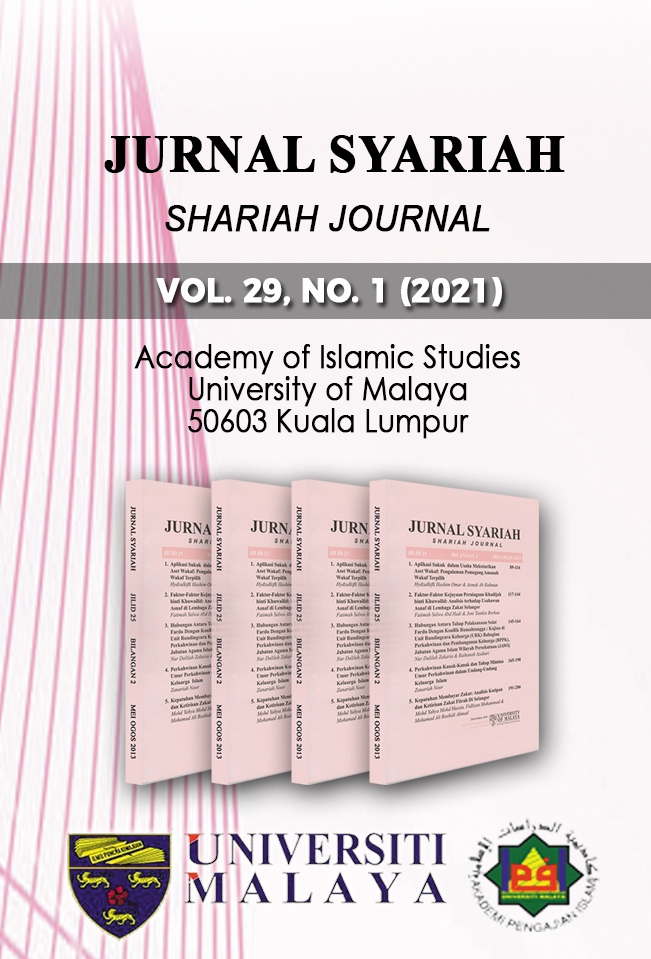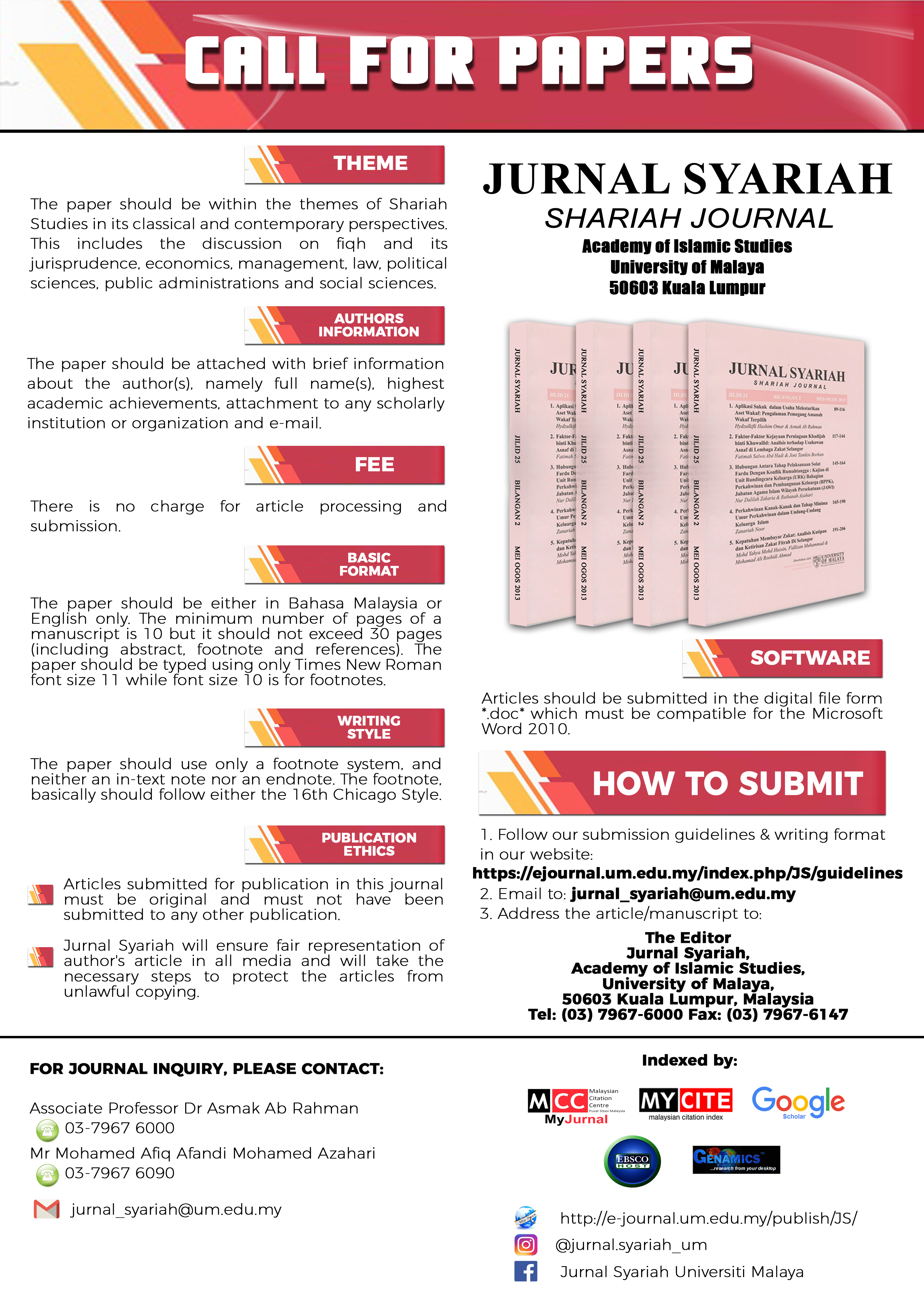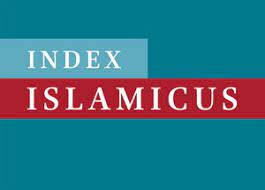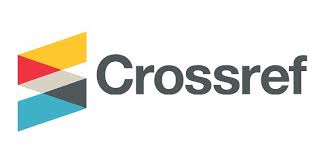LEADERSHIP CHARACTERS IN MALAYSIAN RELIGIOUS-NGOs: AN INTRODUCTORY OVERVIEW
DOI:
https://doi.org/10.22452/js.vol29no1.5Keywords:
leadership characters, religious-NGOs in Malaysia, charismatic, transformational, servantAbstract
Leadership is a key function and process to unlock the effectiveness and enhancement of any organization’s development, including Religious-NGOs (RNGOs). This can be attained via three main characteristics, which are charismatic, transformational and servant leadership. Previous research has proved that these characteristics are relevant for NGOs, but little was found for RNGOs. RNGO is a form of NGO that is well-known for its active role in contributing to a harmonious and religious society. This paper focused on the concept of leadership in RNGOs and an introductory to the identity of Malaysian Islamic RNGOs that are diverse by ethnic identities. This study was qualitative in nature and depended heavily on existing literature and official reports. The study found that all three selected Islamic RNGOs that represent the Malay Muslims, Chinese Muslims and Indian Muslims adopt and practice charismatic, transformational and servant leadership in executing their organizations’ objectives, which could possibly be a yardstick to effective RNGO leadership development in the future.
Downloads
References
Angkatan Belia Islam Malaysia, ‘Profil Sejarah ABIM,’ http://www.abim.org.my/profil/sejarah-abim.html, accessed on 20th September 2017.
Balkundi, P. & Kilduff, M., ‘The Ties that Lead: A Social Network Approach to Leadership,’ The Leadership Quarterly, vol. 17 (2006): 419-439.
Barbuto Jr, John E. & Daniel W. Wheeler, ‘Scale Development and Construct Clarification of Servant Leadership,’ Group & Organization Management, vol. 31/3 (2006): 300-326.
Beekun, Rafik Issa & Jamal A. Badawi, Leadership: An Islamic Perspective (Beltsville, MD: Amana, 1999).
Berger, Julia, ‘Religious Non-Governmental Organizations: An Exploratory Analysis,’ Voluntas: International Journal of Voluntary and Nonprofit Organizations, vol. 14/1 (2003): 15-39.
Borneo Post, ‘Kuching City Floating Mosque Ready,’ http://borneobulletin.com.bn/kuching-city-floating-mosque-ready-2018/, accessed on 27 September 2017.
Budiwanti, Erni, ‘Malaysian Indian Muslim’s Oscillating Identity: Swinging Between Home and Host Countries,’ in From Conflict to Peace Building and Democratization: Muslim Minorities in Southeast Asia (Thailand: API Regional Coordinating Institutions, 2012), 81-87.
Burns, James, Leadership (New York: Harper & Row, 1978).
Carlos Pastor, Juan & Margarita Mayo, ‘Transformational Leadership among Spanish upper Echelons: The Role of Managerial Values and Goal Orientation,’ Leadership & Organization Development Journal, vol. 29/4 (2008): 340-358.
Carter, D.R., DeChurch, L. A., Braun, M. T. & Contractor, N. S., ‘Social Network Approaches to Leadership: An Integrative Conceptual Review,’ Journal of Applied Psychology, vol. 100/3 (2015): 597-622.
Chin, D. T., & Wendy A. Smith, ‘An Inductive Model of Servant Leadership: The Considered Difference to Transformational and Charismatic Leadership,’ Working Paper 43/06, Department of Management, Monash University (2006), 1-19.
Conger, Jay A. & Rabindra N. Kanungo, ‘Toward A Behavioral Theory of Charismatic Leadership in Organizational Settings,’ Academy of Management Review, vol. 12/4 (1987): 637-647.
Connaughton, M. J., & Hassinger, J. ‘Leadership character: antidote to organizational fatigue.’ Journal of Nursing Administration, vol. 37/10 (2007): 464-470.
Covey, Stephen R., ‘Servant-leadership from the Inside Out,’ in Insights on Leadership: Service, Stewardship, Spirit and Servant-leadership, ed. Spears, L. C (New York: John Wiley & Sons, 1998), xi-xviii.
Dansereau, F., Jr., Graen, G. & Haga, W. J., ‘A Vertical Dyad Linkage Approach to Leadership within Formal Organizations: A Longitudinal Investigation of the Role Making Process,’ Organizational Behavior and Human Performance, vol. 13 (1975): 46-78.
DeRue, D. S. ‘Adaptive Leadership Theory: Leading and Following as a Complex Adaptive Process,’ Research in Organizational Behavior, vol. 31 (2011): 125-150.
Dinh, J. E. & Lord, R. G., ‘Implications of Dispositional and Process Views of Traits for Individual Difference Research in Leadership,’ The Leadership Quarterly, vol. 23/4 (2012): 651-669.
Dinh, J. E., Lord, R. G., Gardner, W. L., Meuser, J. D., Liden, R. C. & Hu, J., ‘Leadership Theory and Research in the New Millennium: Current Theoretical Trends and Changing Perspectives,’ The Leadership Quarterly, vol. 25/1 (2014): 36-62.
Dion, Michel, ‘Are Ethical Theories Relevant for Ethical Leadership?’ Leadership & Organization Development Journal, vol. 33/1 (2012): 4-24.
Eberly, M. B., Johnson, M. D., Hernandez, M. & Avolio, B. J., ‘An Integrative Process Model of Leadership: Examining Loci, Mechanisms, and Event Cycles,’ American Psychologist, vol. 68 (2013): 427-443.
Fernandez, R. M., ‘Structural Bases of Leadership in Intraorganizational Networks,’ Social Psychology Quarterly, vol. 54 (1991): 36-53.
Follet, M. P., ‘Power,’ in Dynamic Administration: The Collected Papers of Mary Parker Follet, ed. H. C. Metcalf & L. Urwick (New York: Harper, 1925).
French, J. R. P. & Raven, B., ‘The Bases of Social Power,’ in Studies in Social Power, ed. D. Cartwright (Ann Arbor: University of Michigan, 1959).
Friedrich, T.L., Vessey, W.B., Schuelke, M.J., Ruark, G.A., & Mumford, M.D., ‘A Framework for Understanding Collective Leadership: The Selective Utilization of Leader and Team Expertise within Networks,’ The Leadership Quarterly, vol. 20 (2009): 933-958.
Ghere, R. K., ‘NGO Leadership and Human Rights,’ http://ecommons.udayton.edu/cgi/viewcontent.cgi?article=1045&context=pol_fac_pub, accessed on 21 September 2017.
Gibb, C.A., ‘Leadership,’ in Handbook of social psychology, ed. G. Lindzey (Reading, MA: Addison Wesley, 1954).
Gill, Roger, Theory and Practice of Leadership (London: Sage Publications, 2013).
Greenleaf, Robert K., Servant Leadership (New York: Paulist Press, 1977).
Hackman, J.R. & Wageman, R., ‘Asking the Right Questions about Leadership: Discussion and Conclusions,’ American Psychologist, vol. 62 (2007): 43-47.
Hailey, J. & James, R., ‘Trees Die from the Top: International Perspectives on NGO Leadership Development,’ Voluntas: International Journal of Voluntary and Nonprofit Organizations, vol. 15/4 (2004): 343-353.
Hale, Jeff R. & Dail L. Fields, ‘Exploring Servant Leadership Across Cultures: A Study of Followers in Ghana and the USA,’ Leadership, vol. 3/4 (2007): 397-417.
Han, Yong, Nada K. Kakabadse & Andrew Kakabadse, ‘Servant Leadership in the People’s Republic of China: A Case Study of the Public Sector,’ Journal of Management Development, vol. 29/3 (2010): 265-281.
Herman, H. M. & Warren CK Chiu, ‘Transformational Leadership and Job Performance: A Social Identity Perspective,’ Journal of Business Research, vol. 67/1 (2014): 2827-2835.
Hesse, Hermann, The Journey to the East: A Novel (Farrar: Straus and Giroux, 2013).
Hicks, George, ‘Chinese Organizations in Southeast Asia in the 1930s,’ in Social Movement in Malaysia. ed. Saliha Hassan & Meredith L. Weiss. (Singapore: Select Books, 1996), 76-90.
Hogg, M. A., ‘A Social Identity Theory of Leadership,’ Personality and Social Psychology Review, vol. 5 (2001): 184-200.
Hollander, E. P., & Julian, J. W., ‘Contemporary Trends in the Analysis of Leadership Processes,’ Psychological Bulletin, vol. 71 (1969): 387-397.
Hollander, E. P., ‘Legitimacy, Power, and Influence: A Perspective on Relational Features of Leadership,’ in Leadership Theory and Research: Perspectives and Directions, ed. M. M. Chemers & R. Ayman (San Diego, CA: Academic Press, 1993).
House, R. J. & Baetz, M.L., ‘Leadership: Some Empirical Generalizations and New Research Directions,’ in Research in Organizational Behavior, ed. Staw, B.M. (Greenwich: JAI Press, 1979).
Howell, J. M. & Shamir, B., ‘The Role of Followers in the Charismatic Leadership Process: Relationships and their Consequences,’ Academy of Management Review, vol. 30 (2005): 96-112.
Hussain, Muzaffar, ‘The Islamic Polity of Abdul A’la al-Mawdudi,’ VFAST Transactions on Islamic Research, vol. 3/1 (2014): 13-21.
Javidan, Mansour & David A. Waldman, ‘Exploring Charismatic Leadership in the Public Sector: Measurement and Consequences,’ Public Administration Review, vol. 63/2 (2003): 229-242.
Jay Lorsch, ‘A Contingency Theory of Leadership,’ in Handbook of Leadership Theory and Practice, ed. Nitin Nohria & Rakesh Kurana (Boston, MA: Harvard Business Press, 2010).
Jayakody, J. A. S. K., ‘Charismatic Leadership in Sri Lankan Business Organizations,’ Journal of Management Development, vol. 27/5 (2008): 480-498.
Johnson, R.E., ‘Not all Leader-Member Exchanges are Created Equal: Importance of Leader Relational Identity,’ The Leadership Quarterly, vol. 21/5 (2010): 796-808.
Kean, Tan Boon & Bishan Singh, ‘The Role of NGOs in Development-Malaysian Case Study,’ in Uneasy Relations: The State and the NGOs in Malaysia (Kuala Lumpur: Gender and Development Programme, Asian and Pacific Development Center, 1994).
Khan, A. (2007), ‘Islamic leadership principles-a model of success for everyone at all times,’ http://www.irfi.org/articles/articles_1401_1450/islamic_leadership_principles.html, accessed on 27 September 2017.
Klein, K. J. & House, R. J. ‘On fire: Charismatic Leadership and Levels of Analysis,’ The Leadership Quarterly, vol. 6 (1995): 183-198.
Loi, Raymond, Hang‐Yue Ngo, Lingqing Zhang & Victor P. Lau, ‘The Interaction between Leader-Member Exchange and Perceived Job Security in Predicting Employee Altruism and Work Performance,’ Journal of Occupational and Organizational Psychology, vol. 84/4 (2011): 669-685.
Lord, R. G. & Dinh, J. E., ‘What have we Learned that is Critical in Understanding Leadership Perceptions and Leader-Performance Relations? Industrial and Organizational Psychology,’ Perspectives on Science and Practice, vol. 7 (2014): 158-177.
Makmor Tumin, ‘NGO dalam Sistem Demokrasi Malaysia,’ Massa, 16 Mei 1998, 62-63.
Meindl, J. R., ‘The Romance of Leadership as a Follower-Centric Theory: A Social Constructionist Approach,’ The Leadership Quarterly, vol. 6 (1995): 329-341.
Meredith L. Weiss, ‘Malaysian NGOs: History, Legal Framework and Characteristics,’ in Social Movements in Malaysia, ed. Meredith L. Weiss (London: Routledge, 2012).
Michael, H. Hart, The 100: A Ranking of the Most Influential Persons in History (New York: Kensington Publishing Corporation, 1978).
Mitchell, George E., ‘The Attributes of Effective NGOs and the Leadership Values Associated with A Reputation for Organizational Effectiveness,’ Nonprofit Management and Leadership, vol. 26/1 (2015): 39-57.
Mohd Faridh Hafez Mhd Omar & Sharifah Hayaati Syed Ismail, ‘Sumbangan Organisasi Cina-Muslim dalam Keharmonian Beragama di Malaysia: Tinjauan Terhadap Cabaran dan Peranan PERKIM dan MACMA,’ in Isu-Isu Semasa Dakwah dan Golongan Minoriti, ed. Raudah Haji Siren et al. (Kuala Lumpur: Akademi Pengajian Islam, Universiti Malaya, 2016), 1-27.
Mohd Fuad Mohd Salleh, Liku-liku Gerakan Islam di Malaysia: Satu Catatan Awal (Selangor: Imtiyaz Multimedia Publications, 2015).
Mohd. Yusof, Aminuddin, Kepimpinan (Leadership) (Kuala Lumpur: Dewan Bahasa dan Pustaka, 1990).
Morgeson, F.P., DeRue, D.S. & Karam, E.P., ‘Leadership in Teams: A Functional Approach to Understanding Leadership Structures and Processes,’ Journal of Management, vol. 36 (2010): 5-39.
Mumtaz Ahmad, ‘Religious Scholars in the Modern World,’ (Paper presented, the Madrasah Convention organized by MUIS, 15-16 March 2013).
Nabeel Al-Azami, Muhammad 11 Leadership Qualities that Changed the World (California: Claritas Books, 2019).
Omar, Mahyudin & N.H. Abu Samah, ‘The Basis of Leadership in Islam,’ Advances in Natural and Applied Science, vol. 6/8 (2012): 1399-1404.
Osborn, R. N., Hunt, J. G. & Jauch, L. R., ‘Toward A Contextual Theory of Leadership,’ The Leadership Quarterly, vol. 13 (2002): 797-837.
Osman Bakar, ‘An Intercultural Dialogue from within Muslim Communities: A Global Overview,’ in Agree to Differ (UNESCO: Tudor Rose, 2015), 91-97.
Osman Chuah Abdullah, Preaching to the Non-Muslim Chinese in Malaysia (Kuala Lumpur: IIUM Press, 2009).
Pearce, C. L. & Conger, J. A., Shared Leadership: Reframing the Hows and Whys of Leadership (Thousand Oaks, CA: Sage Publication, 2003).
PERMIM, ‘Heritage,’ http://www.permim.org/index.php/aboutus/heritage, accessed on 27 September 2017.
PERMIM, ‘Vision,’ http://www.permim.org/index.php/aboutus/vision, accessed on 27 September 2017.
Persatuan Cina Muslim Malaysia (MACMA), ‘MACMA Branches,’ http://macma.my/main/index.php/macma-branches/, accessed on 27 September 2017.
Pigors, P. J. W., Leadership or Domination (Boston, MA: Houghton Mifflin, 1935).
Politis, John D., ‘Transformational and Transactional Leadership Enabling (Disabling) Knowledge Acquisition of Self-Managed Teams: The Consequences for Performance,’ Leadership & Organization Development Journal, vol. 23/4 (2002): 186-197.
Rajoo. R., ‘World view of the Indians with Regard to Their Social Identity and Belonging in Malaysia,’ in Malaysian Worldview, ed. Mohd Taib Osman (Singapore: ISEAS, 1985).
Roff, William R., The Origins of Malay Nationalism (USA: Oxford University Press, 1994).
Russell, Robert F., ‘The Role of Values in Servant Leadership,’ Leadership & Organization Development Journal, vol. 22/2 (2001): 76-84.
Safi, L., ‘Leadership and Subordination: An Islamic Perspective,’ The American Journal of Islamic Social Sciences, vol. 12/2 (1995): 204-223.
Sarros, James C. & Joseph C. Santora, ‘The Transformational-Transactional Leadership Model in Practice,’ Leadership & Organization Development Journal, vol. 22/8 (2001): 383-394.
Shaharuddin Badaruddin, Masyarakat Madani dan Politik: ABIM dan Proses Demokrasi (Selangor: IDE Sdn. Bhd., 2016).
Uhl-Bien, M., ‘Relational Leadership Theory: Exploring the Social Processes of Leadership and Organizing,’ The Leadership Quarterly, vol. 17 (2006): 654-676.
White, S. C., Devine, J. & Jha, S., ‘The Life A Person Lives: Religion, Well-being and Development in India,’ Development in Practice, vol. 22/5-6 (2012): 651-662.
Willner, A. R., The Spellbinders: Charismatic Political Leadership (New Haven, CT: Yale University Press, 1984).
Xifu Naser, ‘Cina Muslim Perlu Bangkit,’ Sinar Harian Online, http://www.sinarharian.com.my/politik/cina-muslim-perlu-bangkit-1.399109, accessed on 27 September 2017.
Yammarino, F., ‘Leadership Past, Present, and Future,’ Journal of Leadership & Organizational Studies, vol. 20 (2013): 149-155.
Yukl, G. A., Leadership in Organizations (7th ed.) (New Jersey: Pearson-Prentice Hall, 2010).
Yukl, Gary., ‘An Evaluation of Conceptual Weaknesses in Transformational and Charismatic Leadership Theories,’ The Leadership Quarterly, vol. 10/2 (1999): 285-305.
Zehir, Cemal, Büşra Müceldili, Erkut Altindağ, Yasin Şehitoğlu & Songül Zehir, ‘Charismatic Leadership and Organizational Citizenship Behavior: The Mediating Role of Ethical Climate,’ Social Behavior and Personality: An International Journal, vol. 42/8 (2014): 1365-1375.
Downloads
Published
How to Cite
Issue
Section
License

This work is licensed under a Creative Commons Attribution-NonCommercial 4.0 International License.
COPYRIGHT: All rights reserved. Not allowed to be reproduced any part of articles and contents of this journal in any form or by any way, whether electronic, mechanical, photocopying, recording or otherwise without permission in writing from the Chief Editor, Jurnal Syariah.



















